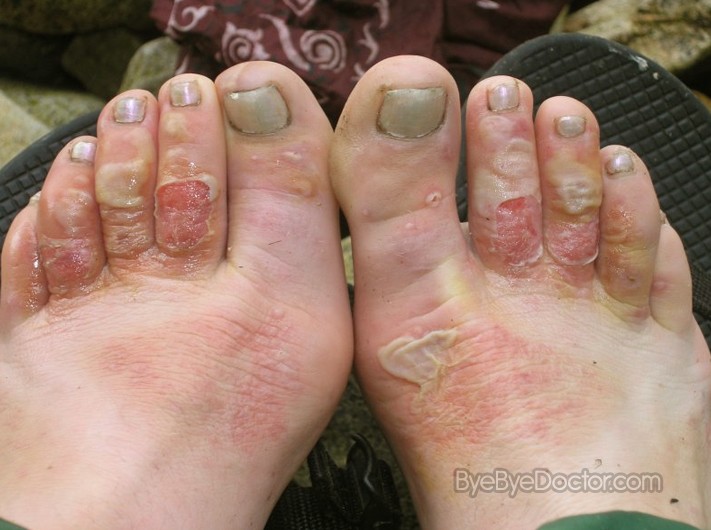What is Trench foot?
This is a medical problem of the feet which develops after prolonged exposure to unsanitary, damp as well as cold conditions. It also is one of the many syndromes which are referred to as “immersion foot syndromes”. The name “trench” is used as a reference to the trench warfare, normally associated with World War I.
This problem with the feet developed in many soldiers while fighting in the First World War. This infection of the feet developed by wet, cold and insanitary conditions in waterlogged trenches which soldiers stood for hours in unable to take off the wet socks or boots. This would gradually cause the feet to go numb as well as the skin would turn blue or red. Left untreated, trench foot often turned gangrenous and resulted in many amputations. During the winter of 1914-1915 there were over 20,000 soldiers in the British Army treated for this condition.
With this condition, the infected feet become numb, developing erythrosis which turns the feet red or cyanosis which turns the feet blue because of a terrible vascular supply. The feet could begin to have the stench of decay due to the early phases of necrosis setting in. When the conditions get worse, the feet can also start to swell. Trench foot in advanced stages often has open sores as well as blisters which can lead to fungal infections. This stage is often called topical ulcer or jungle rot.
When not treated, trench foot normally results in gangrene, which can eventually lead to foot amputation. If this condition is properly treated, a complete recovery is normal, although it can be marked by short-term severe pain as the feeling in the feet returns.
Trench foot Causes
Trench foot is divided into 3 stages. This first one is the time when the blood vessels are constricted by cold and wetness inside the boot or shoe with too little oxygen getting to the foot cells. The foot becomes cold to the touch, a little swollen, discolored slightly, numb, as well as a little tender to the touch. If the foot is re-warmed at this stage, the damaged tissue normally appears red and feels sensitive. This discomfort can last from days to only hours.
Stage two is the time when the foot cells become damaged by the lack of good circulation. When the blood vessels open up, the tissue swells with excess fluid. Individuals complain of pain which is tingling that never goes away. There is more swelling. Upon re-warming, blisters form and then ulcers where the blisters fall off revealing tissue which is dead underneath. In some severe cases, gangrene will result. Suffering can last from 2 to 6 weeks and drugs for pain are prescribed.
Stage three may last for weeks or months. Swelling subsides and the foot starts to look normal again. During this stage, the individual can complain of increased sweating of the foot, increase cold sensitivity, as well as varying degrees of itching, pain as well as creeping, tingling, prickly feeling.
Trench foot Symptoms
- Tingling and/or itching sensation
- Burning sensation
- Loss of feeling
- Pain
- Swelling
- Cold and blotchy skin
- Numbness
- Foot can appear cyanotic (gray)
- Prickly or heavy feeling
- Foot is dry, red as well as painful after warming
- While warming burning can be severe
- Fissures as well as maceration of the skin is common
- Blisters
- Skin as well as tissue dying and falling off
- Can involve heel, toes, and entire foot
Trench foot Treatment
Prevention is the key in treating this condition. Limit exposure to cold is very important in stopping as well as treating trench foot. It is a must to maintain a dry environment inside the shoe. Controlling any excessive perspiration will help.
http://www.Symptoms-Causes-treatment.blogspot.com detect diseases at an early stage symptoms, and find out the causes and treatments best suited.
When exposed to wet and cold condition, the feet when possible should be air-dried and elevated and there should be an exchange of wet socks and shoes for dry ones so that trench foot does not begin to develop.
The treatment for this condition is very close to the treatment for frostbite. The following steps should be taken:
- Clean and dry thoroughly the feet
- Avoid synthetic type materials such as vinyl or rubber
- Wear cloth or leather which can absorb moisture
- Use dry, clean socks daily
- Use baby powder or talc to keep moisture away
- Affected area should be treated by applying warm packs or socking in warm water – 102 degrees to 110 degrees for about 5 minutes.
- While resting or sleeping, do not wear socks
- Medical assistance should be obtain as quickly as possible
If the feet have any wounds, they will become very prone to infection. The feet should be checked daily for worsening of symptoms or signs of infections.
Drying agents are helpful to control moisture. Aluminum chloride is the agent most commonly used in the tropics. Formalin is used as well in other prescription medications. Antihistamine an anticholinergic medications should be used in severe cases. These drugs include Banthine, Benadryl or Pro-Bathine.
Where there are severe cases of feet sweating, it can also be treated with surgery as well as injections. Recently, Botox injections have been successfully by dermatologists and podiatrists. Botox is used to paralyze the smooth muscle which regulates the sweat glands on the bottom of the foot.
An endoscopic excision of the dorsal root ganglion is another method used by neurosurgeons to create an environment of surgical anhydrosis – absence of perspiration – by removing surgically the component of the nervous system that is responsible for autonomic functions such as perspiration.
Trench Foot Pictures






